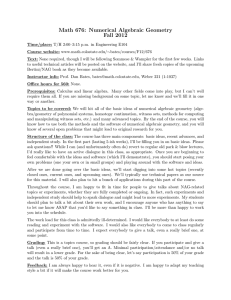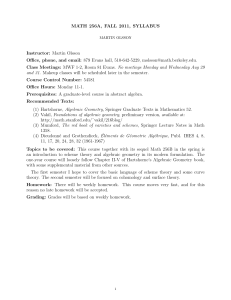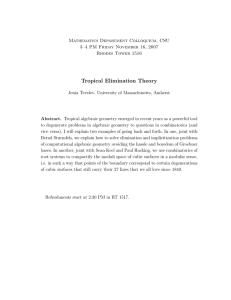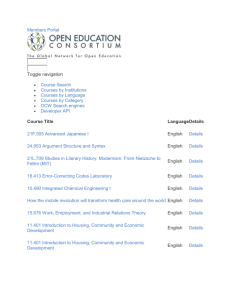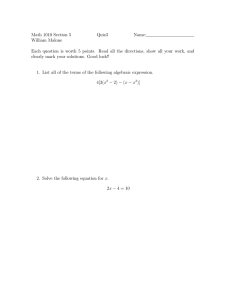Math 676: Computational Algebraic Geometry
advertisement
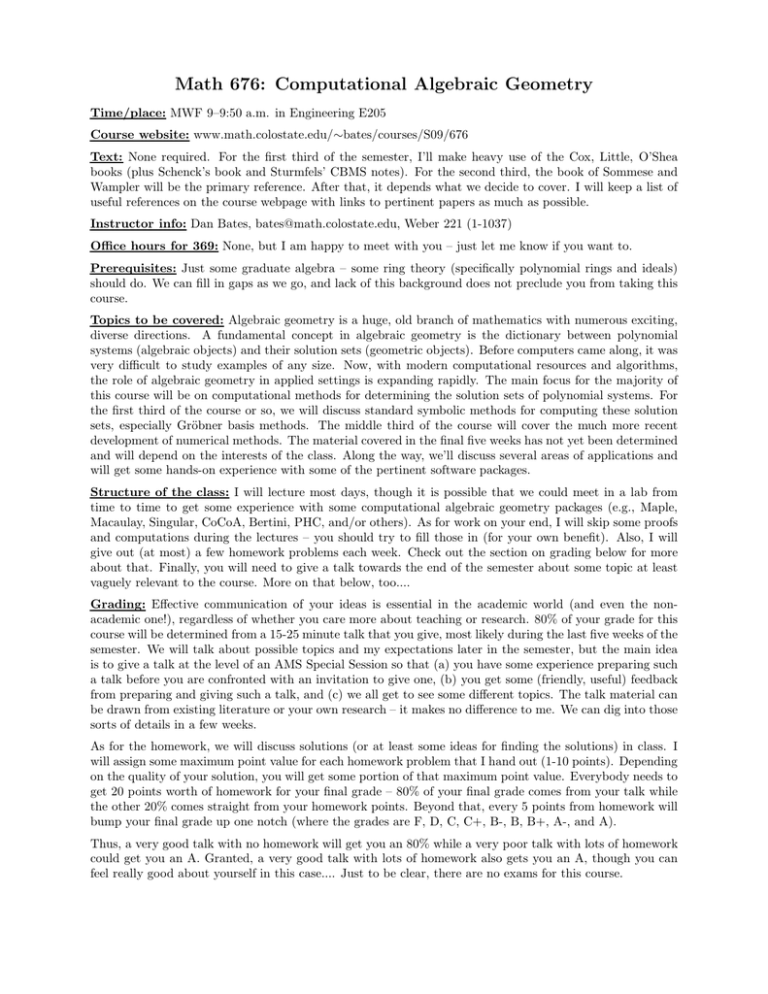
Math 676: Computational Algebraic Geometry Time/place: MWF 9–9:50 a.m. in Engineering E205 Course website: www.math.colostate.edu/∼bates/courses/S09/676 Text: None required. For the first third of the semester, I’ll make heavy use of the Cox, Little, O’Shea books (plus Schenck’s book and Sturmfels’ CBMS notes). For the second third, the book of Sommese and Wampler will be the primary reference. After that, it depends what we decide to cover. I will keep a list of useful references on the course webpage with links to pertinent papers as much as possible. Instructor info: Dan Bates, bates@math.colostate.edu, Weber 221 (1-1037) Office hours for 369: None, but I am happy to meet with you – just let me know if you want to. Prerequisites: Just some graduate algebra – some ring theory (specifically polynomial rings and ideals) should do. We can fill in gaps as we go, and lack of this background does not preclude you from taking this course. Topics to be covered: Algebraic geometry is a huge, old branch of mathematics with numerous exciting, diverse directions. A fundamental concept in algebraic geometry is the dictionary between polynomial systems (algebraic objects) and their solution sets (geometric objects). Before computers came along, it was very difficult to study examples of any size. Now, with modern computational resources and algorithms, the role of algebraic geometry in applied settings is expanding rapidly. The main focus for the majority of this course will be on computational methods for determining the solution sets of polynomial systems. For the first third of the course or so, we will discuss standard symbolic methods for computing these solution sets, especially Gröbner basis methods. The middle third of the course will cover the much more recent development of numerical methods. The material covered in the final five weeks has not yet been determined and will depend on the interests of the class. Along the way, we’ll discuss several areas of applications and will get some hands-on experience with some of the pertinent software packages. Structure of the class: I will lecture most days, though it is possible that we could meet in a lab from time to time to get some experience with some computational algebraic geometry packages (e.g., Maple, Macaulay, Singular, CoCoA, Bertini, PHC, and/or others). As for work on your end, I will skip some proofs and computations during the lectures – you should try to fill those in (for your own benefit). Also, I will give out (at most) a few homework problems each week. Check out the section on grading below for more about that. Finally, you will need to give a talk towards the end of the semester about some topic at least vaguely relevant to the course. More on that below, too.... Grading: Effective communication of your ideas is essential in the academic world (and even the nonacademic one!), regardless of whether you care more about teaching or research. 80% of your grade for this course will be determined from a 15-25 minute talk that you give, most likely during the last five weeks of the semester. We will talk about possible topics and my expectations later in the semester, but the main idea is to give a talk at the level of an AMS Special Session so that (a) you have some experience preparing such a talk before you are confronted with an invitation to give one, (b) you get some (friendly, useful) feedback from preparing and giving such a talk, and (c) we all get to see some different topics. The talk material can be drawn from existing literature or your own research – it makes no difference to me. We can dig into those sorts of details in a few weeks. As for the homework, we will discuss solutions (or at least some ideas for finding the solutions) in class. I will assign some maximum point value for each homework problem that I hand out (1-10 points). Depending on the quality of your solution, you will get some portion of that maximum point value. Everybody needs to get 20 points worth of homework for your final grade – 80% of your final grade comes from your talk while the other 20% comes straight from your homework points. Beyond that, every 5 points from homework will bump your final grade up one notch (where the grades are F, D, C, C+, B-, B, B+, A-, and A). Thus, a very good talk with no homework will get you an 80% while a very poor talk with lots of homework could get you an A. Granted, a very good talk with lots of homework also gets you an A, though you can feel really good about yourself in this case.... Just to be clear, there are no exams for this course. Feedback: I want it! I want this class to go well both for you and for me. I may survey you from time to time, but if you are concerned about some aspect of the class or have some idea about how to make it better, please let me know. If you have a problem that you feel needs to be addressed by somebody above me, Professor Tavener is probably the right person to see. Final Note: You should know that I have insulin-dependent diabetes and may therefore need to sit down and take it easy occasionally. There is also the very slight risk that I could have very low blood sugar at some point, causing me to pass out. If that happens (the probability of this is nearly zero), I will need somebody to call 911. Please don’t worry: I haven’t passed out yet and don’t intend to!
